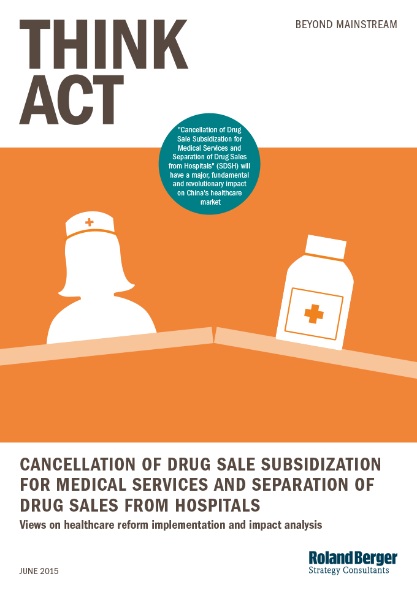Cancellation of drug sale subsidization for medical services and separation of drug sales from hospitals
![{[downloads[language].preview]}](https://www.rolandberger.com/publications/publication_image/roland_berger_tab_chinese_pharma_market_20150703_1_download_preview.png)
In this publication, we trace the regulatory evolution of the SDSH.


At present, hospitals account for about 92% of China’s prescription drug sales—a situation that is about to fundamentally change. The "cancellation of drug sale subsidization for medical services and separation of drug sales from hospitals" (SDSH), a healthcare reform voiced during the 18th National Congress of the Communist Party of China (NCCPC), will have a profound impact on China's healthcare system. These new guidelines and initiatives won’t just radically shift public hospitals’ emphasis back to their core function as healthcare service providers—and away from profit-driven mechanisms—but will also create a major, long-term impact on the pharmaceuticals market and industry.

In this publication, we trace the regulatory evolution of the SDSH. We follow its development from its infancy in the late 90s through multiple stages of early implementation in order to lay the groundwork for a deep, historically-based understanding of this complex issue. According to our analysis, the SDSH will be substantially and widely implemented during the 13th Five Year Plan and will have a revolutionary impact on the business models and operations of healthcare players, including pharmaceutical companies, medical device manufacturers, distributors, healthcare service providers, and retail pharmacies. To round out a number of perspectives given in this report, we also include exclusive insights from three industry insiders.

According to Roland Berger Greater China Partner Joe Jin, pharmaceutical industry players should take action early. "The government has clearly signaled its readiness to cancel 'drug sale subsidization for medical services,' and there have been numerous signs of the changes to come," said Mr. Jin. "We believe this policy will be implemented forcefully and at an unprecedented speed and scale. Under these conditions, the only way for companies and institutions across the industry to ensure future success is to proactively make preparations and position themselves in advance of the coming changes." In this light, we conclude our report with a series of recommendations for players across the value chain to both prepare for and to ensure ongoing success.

![{[downloads[language].preview]}](https://www.rolandberger.com/publications/publication_image/roland_berger_tab_chinese_pharma_market_20150703_1_download_preview.png)
In this publication, we trace the regulatory evolution of the SDSH.